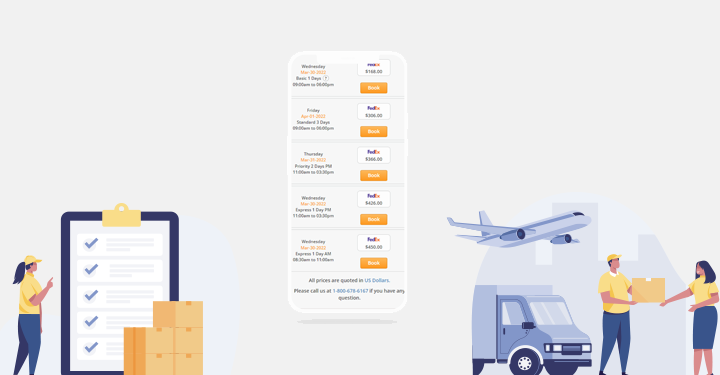Materials, people, and a variety of supply chain activities that move inventory to the end customer are all covered by shipping costs. Unfortunately for shippers, these charges are rarely broken out and explained, making it difficult for them to perceive why shipping might be so expensive.
Explained: Shipping and Handling
The process of preparing, packing, and sending an order to a consumer is referred to as shipping and handling. Consumers are familiar with “shipping and handling” as a category of costs added to their e-commerce orders, but they may be unsure of what it includes. Across all of these processes, the fees are broken down into the expenses of packaging materials, transportation, warehouse space for inventory, delivery, and labor. If there is a task in the supply chain’s post-purchase side, it most likely falls under shipping and handling.
Shipping and handling are two independent operations with the same end aim, even though they are commonly used interchangeably. Picking, packaging, applying the necessary shipping label, are all examples of handling. Transportation, fuel, postage, driver labor, and any fees incurred along the route are all included in shipping costs.
These charges will be factored into delivery prices, and they are only a few of the factors that influence overall shipping costs for online businesses.
Factors that Influence Your Shipping Costs
Shipping is a complicated business with many moving elements, as you know better than anyone. That’s why overall shipping prices are so complicated: there are so many variables to consider. These are a few of the more prevalent ones.
Insurance For Shipping
In an ideal world, every package would arrive on schedule, undamaged, and in the correct location. However, because this is not the case, shipping insurance is necessary. It is also recommended that shippers who send out pricey commodities acquire shipping insurance. It may save them money by allowing them to avoid having to ship replacement inventory on a regular basis. Most carriers charge a percentage of the product’s value.
Shipping Charges
Any services necessary to move a parcel from a warehouse or fulfillment center to the end customer are included in shipping-related expenditures. Human errors and the fees that result, such as adding the incorrect address on a shipping label, are also included in this category.
Duties and Taxes
If you’re shipping to a different country, you’ll have to pay costs based on what you’re shipping and where it’s going. Customs may also seek new invoices if they feel the actual worth of a shipment differs from the claimed value, which could result in an additional cost.
Distance
Aside from the package’s size and weight, the departure point and destination are also significant shipping cost factors. The one easy thing to remember here is that the more the shipment travels, the higher the shipping cost. If you had to transport your package across the state, for example, it would be less expensive than shipping it all the way around the world.
Package Weight And Dimension
This is one of the most important elements in calculating your shipping prices. Simply said, the larger the package, the higher the delivery costs will be. The same is true of package weight: a heavier product will cost more to ship.
While you have no control over the weight of your product, you do have control over the packaging it is sent in. The packaging should be large enough to accommodate your products but small enough to keep the dimensions to a minimum to keep shipping costs down.
Final Pricing Model
There are two pricing models; actual weight and dimensional weight. Actual weight is a very simple term. You can measure your product’s physical weight by putting it on a scale or weight machine. So, actual weight refers to your product’s original or physical weight.
Dimensional Weight is an estimated weight calculated from a product’s length, width, and height. This dimensional weight is used for commercial freight transfer, including postal and courier service
Billable Weight means the rate that you have to pay for shipping. To find out billable weight, compare the package’s actual weight to its dimensional weight. The billable weight will be whichever is greater. For example, Actual Weight is 5 pounds and Dimensional Weight is 8 pounds, then the billable Weight will be considered 8 pounds. On the other hand, if an Actual weight is 10 pounds and the Dimensional weight is 8 pounds, then the billable Weight will be 10 pounds.
Why This Billable System?
Previously billable weight was considered according to the actual weight and distance. That means the more actual weight and distance, the more the charging price will be. But this became a problem when online shopping was spreading. Because of the offers and discounts, the shipping quantity was increasing
One another problem was carrying lightweight packages but occupying huge spaces. That results in more fuel costs and lower returns. That is why all shipping companies decided to consider the greater weight from actual and dimensional weight for charging.
How to Reduce Unnecessary Shipping Charges?
- Check to see if your shipping information is correct and up to date, as well as whether it complies with shipping requirements.
- Don’t use a box that is bigger than you require.
- Check with your preferred carrier to see if there are any surcharges that apply to your shipment.
Join LuggageToShip To Get the Actual Price In Shipping Your Luggage
At LuggageToShip we partner with FedEx, and DHL to handle all your shipping needs door-to-door. All shipping order is completed online at your fingertips, reaching over 220 countries. Our investments in technology make it possible for us to deliver innovations at a faster pace so planning and booking become a more effortless and exciting part of the journey, wherever that leads you.
LuggageToShip.com brands unlock the best possibilities for each individual traveler and each type of trip. So, you can get less shipping price at your convenience.


